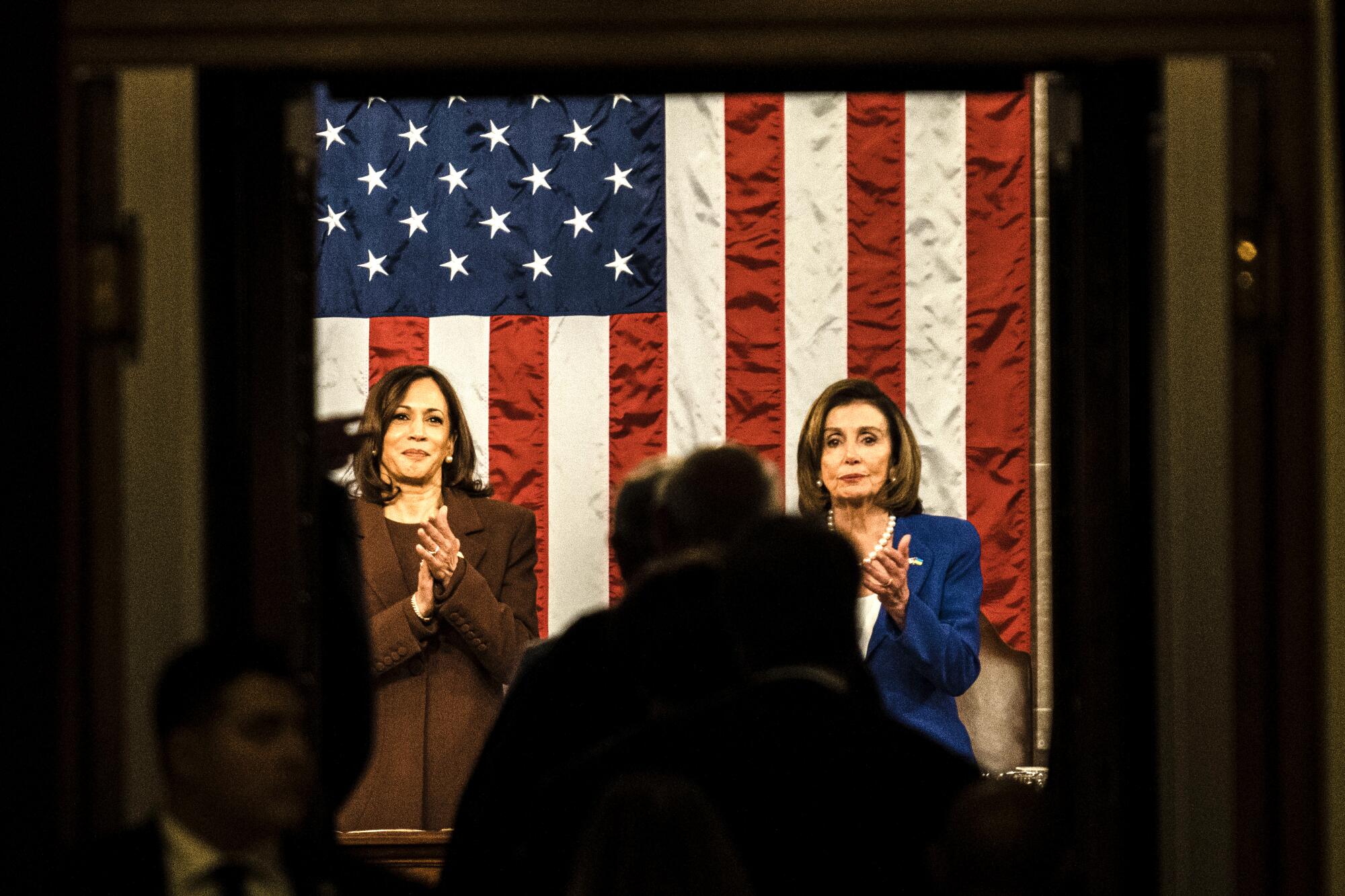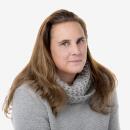
San Francisco — Lateefah Simon, a front-runner to represent Oakland in Congress, still vividly recalls that day in third grade, nearly 40 years ago, when her class took a field trip to San Francisco City Hall.
Simon remembers walking through the grand marble building and sitting cross-legged on the carpet at the feet of then-Mayor Dianne Feinstein, the first woman to hold the job. The mayor — famous for her flawless coiffure, elegant outfits and backbone of steel — delivered a pointed message to the girls in the class: Any one of you can grow up and become a leader.
Simon, 47, who is black and legally blind, grew up poor in San Francisco. She would drop out of high school at 16, rack up shoplifting charges in juvenile court and become a single mother at 19. But she never forgot the lesson of that field trip, of what it felt like to see a woman running her city. And in her early 20s, she got a job working for another barrier-breaking woman: San Francisco’s first female district attorney, Kamala Harris.
Harris pushed Simon to go to college, and she now has not only a master’s degree but, at 26, was awarded a MacArthur “genius” grant for her work with girls in the criminal justice system.
Simon, a Democrat, is running to represent an Oakland seat being vacated by Rep. Barbara Lee. But she said the roots of her success, like those of so many other women in politics, run through San Francisco.
If Harris becomes the nation’s first female president in November, it will be the latest — and greatest — in a long line of female firsts and powerful female leaders from the City by the Bay.

These days, San Francisco is routinely in the national spotlight as the city where Harris launched her political career — and as a favorite punching bag for right-wing media, who offer a caricature of a city in steep decline, overrun by property theft and homelessness.
But the 800,000 people living in the colorful Victorians, Mission Revival homes, Craftsman bungalows and modern flats packed into these fog-kissed hills at the edge of the Pacific Ocean can claim another distinction: Over the last four decades, San Francisco has proved to be an extraordinary launching pad for female leaders, who have emerged from its fierce political cauldron to wield power across the state and national stages.
Feinstein, who died last year at age 90, became San Francisco’s first female mayor in 1978 and went on to become one of the country’s most powerful senators. She was the first woman to chair the Senate Rules Committee and Select Committee on Intelligence, and by the end of her life, was the longest-serving female senator in U.S. history.
Her friend Barbara Boxer was elected to a congressional seat representing northern San Francisco and Marin County in 1982, and entered the Senate with Feinstein in 1993, making California the first state with two female senators.
Nancy Pelosi, elected to a San Francisco congressional seat in 1987, was the first female speaker of the U.S. House of Representatives. She is viewed, even by her detractors, as one of its most powerful leaders.

Eleni Kounalakis, raised in Sacramento, was two decades into her life as a San Franciscan when she won office as California’s first female lieutenant governor. She’s now running for governor, and if elected, would mark another female first.
Before she was the first female vice president, Harris was California’s first female attorney general.
That’s a lot of female firepower from a city that stretches just seven miles by seven miles.
“It is astonishing,” said Mindy Romero, director of USC’s Center for Inclusive Democracy. “It is unprecedented to see one city produce this many high-level, incredibly influential political leaders. And then for them to be women.”
The first generation of female giants who came to power from San Francisco — Feinstein, Boxer and Pelosi — had one thing in common, according to Boxer, who stepped down from the Senate in 2016, clearing the way for Harris to take her seat.
“All of us had been working behind the scenes” as activists, organizers and fundraisers, said Boxer, 83. “And when the women’s movement really started, we said, ‘OK, it’s time to step out.’ ”
They found in San Francisco an electorate that was uniquely receptive. “It takes two to tango,” Boxer said. “The candidate and the constituency.”
San Francisco of the 1980s and 1990s had a remarkably diverse population, spanning wealthy, poor, and middle class, Black, white, Latino and Asian. The area was rich with transplants from other states and countries — and rich, too, with people engaged in struggles for liberation, including gay rights, women’s rights, the Black Panthers, the Chicano Movement.
“The people there came from everywhere, to find equality and find a voice,” Boxer said. “And when they looked at us, they said, ‘This is a good voice for me.’ … It was fertile ground for a qualified woman to get a chance.”
These early female leaders were also boosted by a political organization that, unlike the political machines in many big cities, was open to women having power.
In an interview this week, John Burton, 91, the former congressman, state Senate leader and California Democratic Party chair who has served as a king- and queen-maker in San Francisco for decades, said he wasn’t sure what it was about his city that had nurtured so many successful elected women. “Who the hell knows,” he said, in what was actually mild language for the famously profane but beloved power broker.

But a lot of observers think the answer involves Burton himself, along with his brother, longtime Congressman Phillip Burton; Phillip’s wife, Sala, who was his partner in shaping San Francisco’s political scene; and their longtime political ally Willie Brown, who wielded tremendous influence as an Assembly speaker and later as San Francisco mayor.
Together, those four made up a political force that shaped San Francisco, state and national politics for decades. The Burton brothers served San Francisco in Congress from nearby districts, and when Phillip Burton died in 1983, his widow, Sala, took his seat and occupied it until her own death in 1987.
The list of women who have emerged from the Burton-Brown political organization speaks for itself: Pelosi worked with them as a prolific fundraiser and strategist. Boxer worked for John Burton as a legislative aid and won the congressional seat he vacated in the early 1980s. Fiona Ma, the current state treasurer, worked for Burton as a field representative.

Brown, meanwhile, was an early mentor for Harris, appointing her to seats on the state Unemployment Insurance Appeals Board and the California Medical Assistance Commission before she was elected San Francisco district attorney in 2003. The two also briefly dated.
And although Feinstein did not come up through the Burton-Brown organization, Brown recalled that he worked on issues with her, including fair housing, as far back as the early 1960s.
“She showed up for the first demonstration in the city, probably 1961, where she was pushing a stroller with her daughter. And that’s how I met her,” Brown recalled upon her death.
There was another feature of San Francisco that prepared the female politicians who emerged there: Its notoriously cutthroat politics, which require candidates to be equally adept at coalition building, retail politics and tossing knife-sharp elbows at their political opponents.
“San Francisco politics is rough and tumble,” Harris said last year, delivering a eulogy at Feinstein’s funeral. “A bare-knuckled sport.”
“It’s like crabs in a pot,” said Ma. “Once you get out of the pot, you’re just that much tougher.”

“A gladiator ring,” agreed Susannah Delano, executive director of Close the Gap, an organization that recruits progressive women to run for the state Legislature. “A combat-rich zone.”
Whatever the metaphor, to win election in San Francisco, candidates had to be seasoned politicians, even for the smaller offices. And once they won in San Francisco, these women proved adept at pivoting out of the city’s progressive enclaves and moderating their images to be able to win on a statewide and national level.
“When we’re talking about Feinstein, Boxer, Harris, they ran largely centrist campaigns to appeal to both the coastal and the interior voters of California,” said Keally McBride, a professor of political science at the University of San Francisco.
And, of course, money matters in politics. San Francisco is full of rich people who care about politics, and candidates are able to tap deep veins of financial support.
And maybe, one prominent fundraiser for numerous female candidates speculated, the prominence of women in San Francisco has even deeper roots.
“Women have run this town since the 1906 earthquake,” said Susie Tompkins Buell, a Democratic donor and co-founder of retail brands Esprit and North Face. “It was a miners’ town, and the madams knew where all the bodies were buried.”
Domineering madams aside, the modern trailblazer was Feinstein.
Born and raised in San Francisco, she was elected to the Board of Supervisors in 1969 and became the board’s first female president. She waged two unsuccessful campaigns for mayor, then ascended in the midst of tragedy: In November 1978, former Supervisor Dan White assassinated Mayor George Moscone and Supervisor Harvey Milk, California’s first out gay elected official. Feinstein stepped into the top job, taking the helm of a city in mourning and going on to be named the “most effective mayor” in the country in 1987 by City and State magazine.
In 1990, she launched a campaign for governor, but lost to Republican Sen. Pete Wilson. Undeterred, she jumped into a race for his old Senate seat in 1992. Because Feinstein was running in a special election to fill a vacancy, she went to Washington first. Two months later, Boxer joined her and would go on to become a prominent voice on children’s programs and the environment.
Also in Washington by then was Pelosi, who was elected to the House in 1987.
They were in a minority, among just 54 women in Congress in that 1993 session. In 2023, there would be 151 women out of 535 seats in the House and Senate.
“We didn’t realize until we got there that women were depending on us,” Boxer said. “That stuck with us. It wasn’t just representing our district, but representing women everywhere.”
Pelosi quickly emerged as a force in the House.
Originally from political royalty in Baltimore, where her father and brother both served as mayor, Pelosi had moved to San Francisco in 1969 with her husband, Paul, and devoted herself to raising five children. She spent years raising money for political candidates, working closely with the Burtons, and eventually serving as chair of the California Democratic Party.
Sala Burton, in particular, noted Pelosi’s strategic acumen and leadership potential.
In the hospital dying of cancer, she summoned John Burton, Pelosi and other confidants to her bedside and designated Pelosi as her successor. Pelosi went on to win a special election in 1987 with John Burton as her campaign chair.

In those early years, Pelosi regularly confronted sexism, even in liberal San Francisco. In that first election, she was asked who would take care of her children and was dismissed as “only a mom,” said Pelosi’s daughter, Christine.
She prevailed, nonetheless. And in the late 1990s, dismayed that Democrats were not winning enough congressional elections, Pelosi decided to run for leadership in the House. At one point, as recounted in Susan Page’s book “Madam Speaker,” she told her friend Rep. George Miller: “I don’t think these boys know how to win.”
At another point, according to Page’s book: “Party elders approached her with a tone-deaf offer, a dumbfounding miscalculation of the challenge she was about to pose.” Women representatives in Congress, the men told her, should forward a list of things they wanted, and the men would “get them done for you.”
Instead, in a secret ballot held in October 2001, Pelosi was elected minority whip, becoming the highest-ranking woman in the history of Congress. In 2007, she became House speaker.
She would serve two turns as speaker, working alongside four presidents: George W. Bush, Barack Obama, Donald Trump and Joe Biden. And during that time, she helped muscle through landmark legislation, including sweeping banking reforms, the Affordable Care Act and a repeal of the U.S. military’s “don’t ask, don’t tell” policy. When she relinquished her leadership role in 2022, she was lauded as one of the most effective leaders to ever occupy the seat.
Pelosi used her skills as a fundraiser and strategist to advance not only her own career but also to propel other women into office. In the Bay Area, she supported the careers of many women, including Rep. Anna Eshoo (D-Menlo Park) and Rep. Zoe Lofgren (D-San Jose).
The importance of having more women in power was a theme Pelosi struck often. In 2017, speaking at a women’s march, she said: “Nothing is more wholesome to the political process or the governance of our country than the fuller participation and leadership of women.”
A notable exception to the list of women Pelosi boosted early in their careers is Harris. When Harris, then a 39-year-old lawyer, jumped into the race for San Francisco district attorney in 2003, Pelosi endorsed the incumbent, Terence Hallinan.

But there were plenty of other women in San Francisco to help Harris.
Tompkins Buell, the Democratic donor, said she first met Harris around 2003 at a march in Washington. Harris was “fun and smart and informative and attractive and playful,” Tompkins Buell said. “It was something very appealing to be around her.”
Harris eventually served on the board of WomenCount, a nonprofit Tompkins Buell founded that focuses on getting more women into politics. The two remain close friends, and Tompkins Buell and her husband, Mark, who served as Harris’ finance chair in her race for district attorney, still host fundraisers for Harris during her trips back home to San Francisco.
Through Tompkins Buell, Harris met Andrea Dew Steele, an activist who would serve as a political advisor to Harris’ campaign for district attorney.
Dew Steele was dazzled. “Here you had a woman who was taking on a white male incumbent, with the nickname KO [for knock out, from his time as a boxer]. The fact that she could do that, and be embraced by so many people.”
Steele later co-founded Emerge California and Emerge America, organizations that work to recruit, train and elect Democratic women to office.

Harris, meanwhile, kept rising. In 2010 she was elected attorney general, and in 2016 was elected to the Senate. In 2020 she became the first female vice president.
When Biden decided to end his reelection campaign and endorsed Harris, Pelosi quickly did as well.
Along the way, Harris has served as a mentor to many women coming up behind her, among them London Breed, San Francisco’s current mayor.
“I was a Black girl from the projects,” Breed said. “So I never believed growing up that someone like me could ever be in a position like this, until Kamala, really.”

Romero, of the Center for Inclusive Democracy, said a combination of fundraising, networking and political savvy created something that “is greater than the sum of its parts.”
“It is a generation of women who had the wherewithal, the commitment and the drive to seize their individual moments, and also to support other women,” Romero said.
Simon, the congressional candidate who as a young girl visited Feinstein’s mayoral office, said that as she travels the country supporting other female candidates, she realizes anew what a powerful model these giants were. They made the image of women in high office look “normal.”
“Many young people, many women, did not have what we take for granted in this city,” Simon said. “We grew up with women leading. That is not revolutionary anymore here. It is what should be.”
More to Read
Subscriber Exclusive Alert
If you're an L.A. Times subscriber, you can sign up to get alerts about early or entirely exclusive content.
You may occasionally receive promotional content from the Los Angeles Times.












